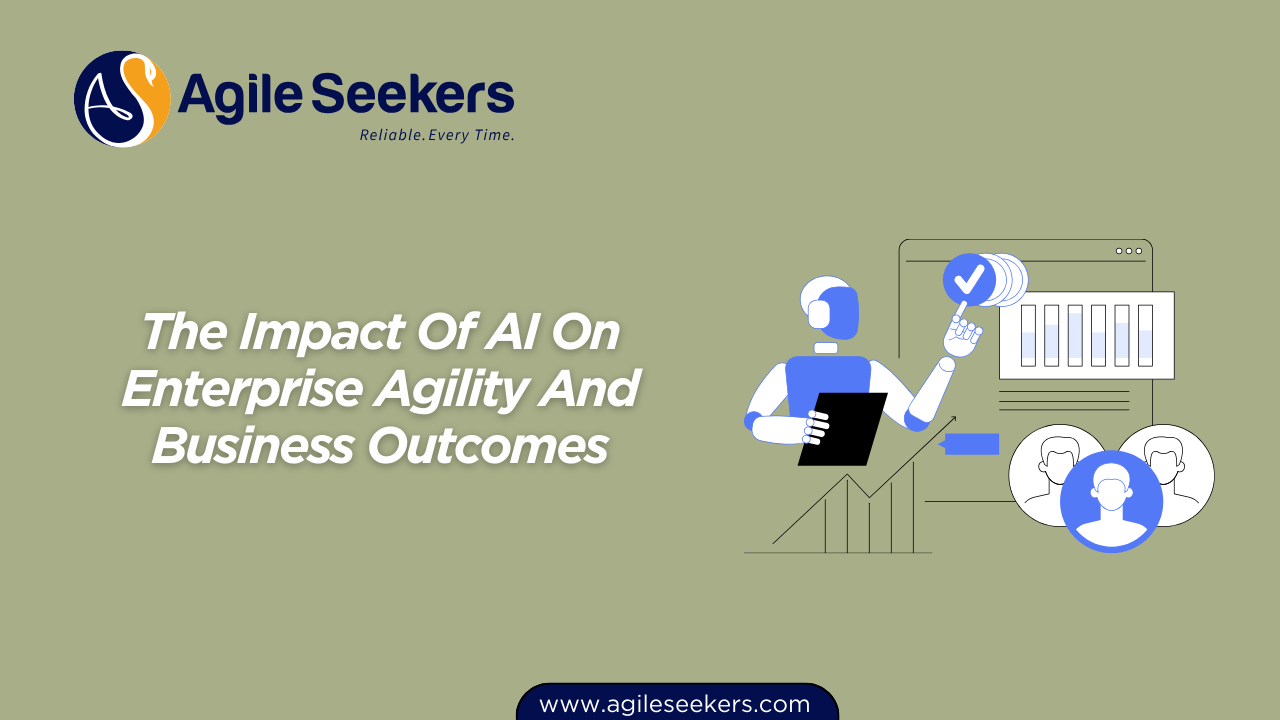The Impact Of AI On Enterprise Agility And Business Outcomes

Artificial Intelligence is no longer a side tool for innovation, it’s becoming a core driver of enterprise agility and business results. Companies that know how to blend AI into their decision-making, workflows, and customer strategies are moving faster, responding better to change, and outperforming competitors. Let’s break down how AI is shaping enterprise agility and the tangible business outcomes that follow.
1. AI as a Catalyst for Enterprise Agility
Enterprise agility is about sensing changes in the market, adapting quickly, and delivering value consistently. AI accelerates this by:
-
Reducing decision latency – AI can process huge data sets in real-time, helping leaders act on market trends or operational issues faster.
-
Improving forecasting accuracy – Predictive analytics spot patterns humans miss, leading to better resource allocation and risk management.
-
Enhancing responsiveness – AI-driven monitoring detects shifts in customer sentiment, competitor moves, or supply chain issues before they escalate.
If you’re leading an agile transformation, pairing it with AI skills—such as those taught in AI for Agile Leaders and Change Agents Certification—can help ensure AI is applied with strategy, not just as a tech add-on.
2. How AI Improves the Core Dimensions of Agility
AI touches each dimension of enterprise agility differently.
Customer-Centricity
Machine learning models analyse customer behavior in detail—identifying emerging needs, predicting churn, and even suggesting product enhancements. This turns feedback loops into a continuous cycle, reducing the gap between customer insight and product change.
Operational Adaptability
AI tools like intelligent automation and process mining reveal inefficiencies and recommend process improvements. Instead of lengthy process redesign projects, AI can pinpoint where change delivers the most value.
Strategic Alignment
AI dashboards help leadership teams prioritise initiatives by mapping their impact on strategic goals. This prevents “pet projects” from soaking up resources without measurable ROI.
Speed to Market
From AI-assisted coding to automated testing, product release cycles shorten without sacrificing quality. Companies like Microsoft and Atlassian have shared how AI-enhanced development pipelines reduce release times significantly (source).
3. Business Outcomes You Can Expect
The value of AI in enterprise agility shows up in measurable business outcomes.
Revenue Growth
When product-market fit is continuously refined through AI insights, new revenue opportunities open faster. AI-enabled companies often see higher upsell and cross-sell rates because their offers are more relevant.
Cost Efficiency
AI optimises workforce deployment, automates repetitive tasks, and improves asset utilisation. For example, predictive maintenance powered by AI can reduce equipment downtime, cutting operational costs by up to 40% in certain industries.
Risk Reduction
From detecting fraudulent activity to identifying compliance issues early, AI reduces exposure to legal, financial, and reputational risks.
Higher Employee Productivity
AI removes manual data crunching from high-value roles, allowing employees to focus on creative problem-solving and customer engagement.
4. Real-World AI in Agile Enterprises
Here’s how forward-thinking enterprises are using AI to improve agility:
-
Agile Portfolio Management: AI analyses delivery metrics to suggest priority shifts across portfolios.
-
Market Scanning: Natural Language Processing (NLP) tools scan industry news, patents, and competitor updates, alerting leaders to opportunities or threats.
-
Talent Allocation: AI recommends the right people for the right initiatives based on skills, workload, and performance history.
-
Customer Support: AI chatbots and knowledge assistants resolve issues instantly, freeing human agents for complex cases.
5. Key Considerations Before Embedding AI
Implementing AI to improve enterprise agility requires careful planning:
-
Data Readiness: AI thrives on quality data. Without clean, integrated data sources, AI recommendations can mislead.
-
Change Management: AI adoption impacts workflows, decision-making styles, and even team structures. Agile leaders must guide teams through this transition.
-
Ethical AI Use: Transparency, bias mitigation, and data privacy are critical to maintaining trust.
-
Iterative Integration: Just like Agile itself, AI adoption should start small, prove value, and scale gradually.
6. Building AI Capabilities into Agile Leadership
For AI to truly boost agility, leaders need to understand both the technology and the mindset shifts it demands. Courses like AI for Agile Leaders and Change Agents Certification provide frameworks for applying AI in governance, portfolio planning, and team coaching. This ensures AI initiatives align with enterprise strategy instead of becoming isolated experiments.
7. The Long-Term Payoff
AI isn’t just a short-term productivity booster—it compounds agility over time:
-
Better Learning Loops: Each project delivers more accurate data for the next.
-
Faster Strategic Pivots: Enterprises respond to economic shifts in weeks, not months.
-
Sustainable Competitive Advantage: Competitors without AI-enhanced agility will struggle to keep pace.
McKinsey’s research suggests that companies combining AI with strong agile practices are twice as likely to be top financial performers in their sector (source).
8. Final Thoughts
Enterprise agility is no longer only about Scrum teams and Kanban boards—it’s about an organisation’s ability to sense, adapt, and deliver value continuously. AI amplifies every part of that capability, turning agility into a measurable driver of business outcomes.
The companies that will win over the next decade are not just agile. They are AI-powered agile—leveraging technology to see further, decide faster, and deliver smarter.
Also read - How To Use Prompt Libraries For Faster Agile Decision Making
Also see - Building Transparent AI Strategies That Support Agile Values




















